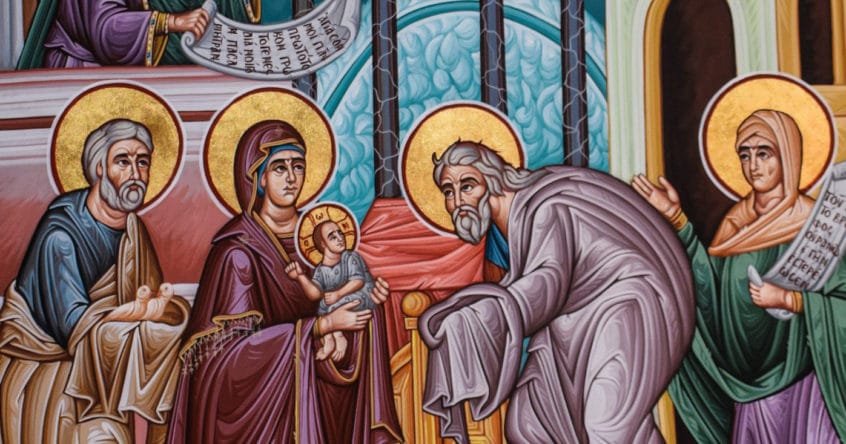
Presentation of the Lord (February 2)
Readings: Malachi 3:1-4 Hebrews 2:14-18 Luke 2:22-40
With the feast of the Presentation, the forty-day Christmas season comes to its true climax. As Christian believers receive blessed candles and process into the church, the community celebrates the joyous purpose of Christ’s coming: the revelation of God’s saving love to the lowly and faithful of Israel and to the whole Gentile world. On a more somber yet consoling note, the community learns that this savior is “a sign that will be opposed” as he comes to establish justice and expiate sin as a suffering but also “merciful and faithful” high priest who will help us in our temptation-filled journeys in the service of God’s justice.
The first reading from Malachi announces the terrible yet purifying arrival of the Lord of hosts in the Temple. In the half century after the completion of the Second Temple (c. 515-450), the once fervent postexilic community lapsed into indifference in cultic matters (Mal 1:6-14) and neglect of covenantal justice (Mal 2:10-16; 3:5). The apparent prosperity of the wicked had led many to question even the justice of God (Mal 2:17). Responding to this general malaise, the prophet as “God’s messenger” (the meaning of Malachi) announces the imminent arrival in the Temple of the holy God of justice who will purify the sons of Levi, known to be performing shoddy services for the community, so that the sacrifices of Judah and Jerusalem will again be acceptable to the Lord. In the next verse (3:5), unfortunately not included in the reading, the prophet announces the Lord’s judgment on the sins against covenantal justice of the whole community: “I will draw near to you for judgment,/ and I will be swift to bear witness against the sorcerers, adulterers, and perjurers,/ those who defraud widows and orphans;/those who turn aside the stranger,/ and those who do not fear me, says the Lord of hosts.”
Hebrews is a treatise written as an exhortation to Christians who are in danger of apostasy, not because of external persecution but from a weariness in living the demands of the Christian calling (see Heb 2:1; 4:14; 6:1-12; 10:23-32). To counteract this indifference to the gospel’s demands, Hebrews presents Jesus in a unique way as “the merciful and faithful high priest” who had a full share in humanity’s condition of being in flesh and blood, including a life of testing, temptation, suffering and death. Jesus’ death was not a defeat, but rather a victory that robbed “the devil, the prince of death,” of power. Now that Jesus has triumphed through his testing, he is the exalted heavenly high priest who is able to help the children of Abraham; they too must struggle to be faithfully obedient through a pilgrimage of testing and suffering. “Since he was himself tested through what he suffered, he is able to help those who are tempted.”
Luke’s account of the child Jesus’ presentation in the Temple by his pious parents is not only intended to recount the surprisingly joyful fulfillment of messianic expectations but also to introduce the ominous note of opposition, rejection and suffering in Jesus’ ministry His arrival in the Temple begins the fulfillment of Malachi’s prophecy (Mal 3:1); by the end of the gospel and throughout Acts, it will be clear that the Temple is doomed for its rejection of Jesus (cf. 13:34-35; 19:41-48; 21:5-6; Acts 7). Like the pious Zechariah and Elizabeth (1:6), Jesus’ parents fulfill the laws for the purification of the mother (cf. Lev 12:2-8) and the dedication of the first-born (Ex 13:2, 12). The fact that Jesus is brought to the temple for the second ritual, which is not required in the law (Exodus 13; Num 3:47-48), is important for Luke’s theology and is probably based on the parallel story of Samuel’s presentation in 1 Sam 1:24-28.
The centerpiece of today’s Gospel scene is Simeon’s Nunc dimittis. As a representative of the `anawim, the poor of the Lord who await the kingdom of justice, Simeon is moved by the Holy Spirit to take Jesus in his arms and proclaim the good news of the long-awaited arrival of the “light of revelation to the Gentiles” (cf. Isa 40:5; 49:6). Simeon’s prophetic vision also encompasses the divisive character of Jesus’ ministry. His proclamation of the Father’s forgiving love is destined to bring about the downfall and rise of many in Israel (see, for example, Luke 7). Mary’s own blessedness will be challenged by Jesus himself when he announces that true blessedness is “hearing the word of God and observing it” (cf. 1:38-45; 2:19; 8:20-21; 11:27-28). Using a familiar Lukan technique, the evangelist pairs Simeon and Anna, another of the `anawim, who as a prophetess thanks God for the Messiah’s arrival and begins to talk about the child “to all who looked forward to the deliverance of Jerusalem.”
No comments:
Post a Comment